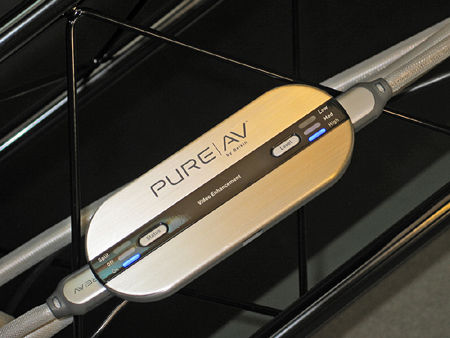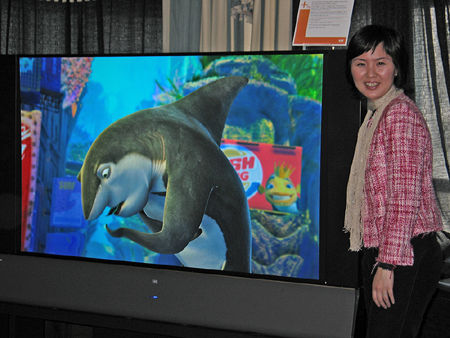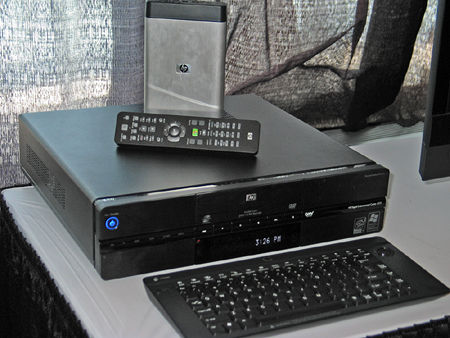HE2005 Day 2: Scott Wilkinson

Texas Instruments was showing the 67-inch Samsung 1080p DLP RPTV (right) next to the 70-inch Sony Qualia 006 SXRD (LCoS), and they had an ISF technician set the user controls for the best possible picture from both without a full calibration. Both sets were fed a 1080i image from the same video server. The most interesting comparison was the high-def zone-plate pattern shown here; the Sony exhibited much more aliasing (circular patterns other than the central one). At around $6000, the Samsung is less than half the price of the Sony. On the other hand, it's important to remember that the demo was conducted by TI, who has a vested interest in making sure that DLP looks as good as it can. It's entirely possible that the Sony will outperform the Samsung on other tests.

Belkin introduced the RazorVision ($249, August), the newest member of their Pure AV line of consumer products. The RazorVision is a little gizmo that is inserted in the DVI or HDMI stream between the source and display (a component version will be available later), and it provides real-time, image-driven contrast enhancement in different regions of the picture thanks to a proprietary chipset with enough horsepower to do the job. The demo was a split-screen image, one side with the RazorVision, the other side without. I was impressed with the processed image.

Hewlett Packard entered the microdisplay rear-projection market with four DLP models: two 720p (50 and 58 inches) and two 1080p (58 and 65 inches; the 65 incher is shown here). All use Wobbulation technology that was developed by HP and licensed to TI, who calls it SmoothPicture. Wobbulation allows each DMD mirror to address two pixels, cutting the required number of mirrors in half. Other features include a dynamic aperture (auto iris) and 7-segment color wheel for improved contrast ratio as well as a 150W DC UHP lamp for better whites and more accurate color. Perhaps most exciting is the ability to display thumbnails of the image at all inputs to select the one you want; very cool!

HP introduced three new LCD panels (26, 32, and 37 inches, all 1366x768) and three new plasmas (42" ED, 852x480; 42" HD, 1024x768; 50" HD, 1365x768, shown here). All include ATSC and NTSC tuners and are digital cable ready (except the 42ED model), and all have HDMI inputs. The plasmas have enhanced audio systems, and the LCDs exhibit a claimed 12ms response time.

Another HP introduction was the second-generation of their Digital Entertainment Center, with three new models: z552 ($1500), z555 ($2000), and z557 ($2600, shown here), all available now. These are basically Windows PCs in AV-component-type cases, but the user is shielded from Windows by the Media Center interface. New features include high-definition recording from the internal ATSC tuner; there are also two NTSC tuners. All together, you can record three different shows while watching something else playing from the hard disk. Speaking of hard disks, all three models include 300GB internal drives and a bay that will accept a second, hot-swappable hard disk called the Personal Media Drive (the silver thing on top of the main unit in this photo), which has increased in capacity from 160GB to 300GB (with 400 and 500GB not far behind). As if that weren't enough, the DVD recorder will record on DVD±R/RW, including the new dual-layer blanks, and it also includes HP's LightScribe technology, which uses the write laser to burn a label on the other side of the disc.
![]()
Silicon Optix demonstrated their Realta HQV video processing chip using a reference-design circuit board (shown here) as well as the HQV-equipped Denon DVD-5910 DVD player. The chip itself is not visible on the board, but there's one in the lower right of this picture. Incredibly, the chip includes 3000 parallel processors, which can perform a total of one trillion fixed-point operations per second, allowing it to process the image on a pixel-by-pixel basis rather than by field, frame, or region as most others do. The result is a stunning image that's been wowing everyone at the show. Aside from Denon and Algolith, Runco has signed on to use the Realta HQV in their products, and several other manufacturers are also planning to use the chip in TVs, projectors, and AV receivers.

The Silicon Optix demo had no sound (which is actually fine by me when evaluating video performance), because the voltage from one of the wall outlets inexplicably jumped to over 193V, frying the audio equipment being powered from that outlet. Fortunately, it didn't affect the video equipment. Yikes!
- Log in or register to post comments





























































